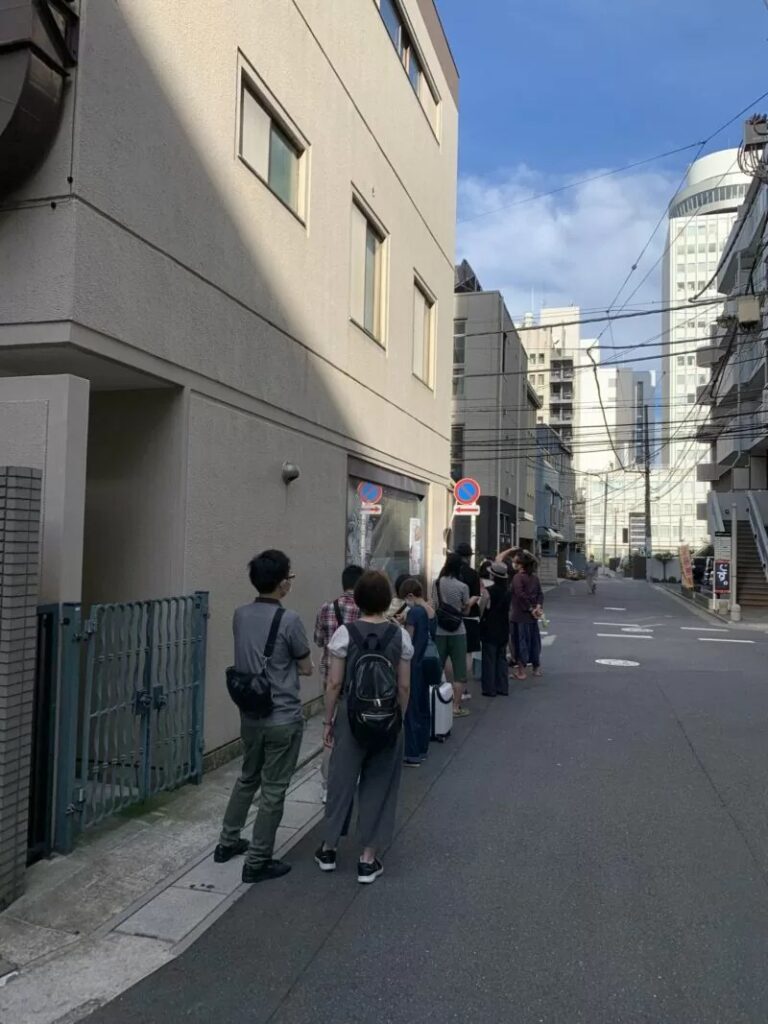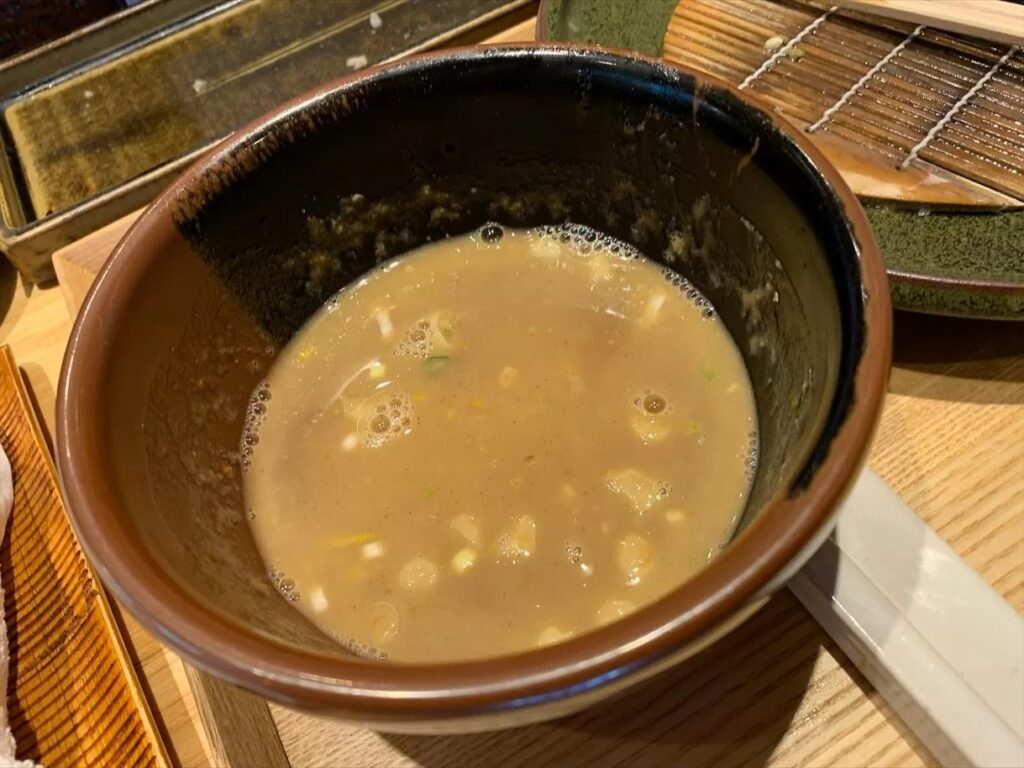I had the legendary tsukemen at the popular ramen restaurant Tomita!

If you want to be sure of eating there, you should line up at 7:00 a.m!😱
Reservations seem to open at 8:00 a.m. on weekdays and at 7:00 a.m. on weekends and holidays, so I’m going to buy my meal ticket first thing in the morning!
With mixed feelings of anticipation and sleepiness in my head, I arrived at Tomita Chinese Soba Restaurant a little before 7:00.
What!
A shocking sight!

Oh My God.😱😱😱😱😱😱😱😱😱
There’s already a line…
And there are quite a few people…
Is this for real…
I thought there would be only one or two people in line, but there are a lot of people in line.
This is indeed a very famous restaurant.


A guidebook of recommended ways to eat and a list of dishes are posted on the side of the restaurant.
It is quite a lot of information, but since the line was moving slowly, I was able to read it carefully. (Laughs)
After waiting in line for about 10 minutes, we finally arrived at the ticket machine
.

I look into the ticket machine with a sense of excitement.
In addition to the very famous tsukemen, there is also ramen.
I guess the first Tomita should be tsukemen.
Tomita’s tsukemen is priced by size,
Mini (1,250 yen/120g) $9.5
Small (1,250 yen/180g) $9.5
Normal (1,300 yen/250g) $10
Large (1,400 yen/350g) $11
Special (1,500 yen/450g) $11.5
Extra large (1,650 yen/550g)$12.5
Since it was 7:00 a.m., I decided to order a small order of tsukemen (1,250 yen), which was just what I had an appetite for.
I then added the special toppings (1,000 yen).
The toppings include four kinds of chashu pork made from TOKYO-X pork and premium hearty yaki-sauce.
The price for this alone is 2,250 yen! $17.5
The price is comparable to that of a theme park.

And in the kitchen, Mr. Tomita himself is carefully preparing the dish.
He carefully arranges the pork toppings in a bowl without sparing any time or effort.
He is a craftsman in his own right.
It is truly impressive.

According to the description, they serve the fantastic pork TOKYO-X with different cooking methods for different parts of the pig.
On this day, the shoulder loin was changed to ribeye.
This is another example of their attention to detail.
The main course of noodles was served by Mr. Tomita, who carefully served it to each of us.
The mini at the far end of the table was finally served the main dish of tsukemen.

Elegant.
Very elegantly presented.
This looks delicious.
Let’s eat!
First of all, as the instruction manual says, eat the noodles without adding anything.

The noodles are so thick that they could be described as udon noodles.
And the transparent white noodles look shiny and divine.
Now, let’s take a bite.
Oh, oh, oh!
The sticky, firm texture gives the noodles a strong presence.
The wheat aroma is strong and slippery, and the texture is great.
You can eat it with just a sprinkle of salt.
Next, let’s take a look at the soup.


The soup is a dark brown, viscous sloppy broth.
The taste is a rich soup with a lot of seafood flavor, but the aftertaste disappears from your mouth without a trace.
The richness of the soup is impressive both in appearance and in the moment you put it in your mouth, but it is the richness that disappears quickly that makes it a taste that you can keep eating forever.
This is a surprise!
It also goes well with the noodles.
It is a tsukemen that is not too heavy, but has a full-bodied and deep flavor.
And the special toppings of 4 kinds of chashu pork and premium heart flavored yakisoba.


These are also fun to eat, as each is made to taste different in character.
You can really never get tired of the different flavors, such as the balsamic sauce served on the side, or the ponzu (Japanese citrus juice) on the yakisoba.
Finally, when we had finished most of the ingredients, the waitress suggested that we have a bowl of soup.
Actually, while I was eating, I was thinking that I would have liked to order soup to go with the soup.
This is also a very neat thing to do.
When I asked for the soup to be wari, the waiter pulled up the bowl of soup, adjusted the amount of soup left over for wari, added chopped yuzu, and served it with soup stock that had a strong aroma of dried bonito flakes.

The last person to bring the soup split is also Mr. Tomita himself, and he hands it to us in a way that conveys his sincerity.
It is a moving experience right to the very end.
The dashi broth is very thick and gives the soup a strong flavor, and the yuzu (Japanese citrus fruit) gives it a refreshing aftertaste.
It was delicious. It was delicious.😁🍜
evaluation😁✨
This time we visited probably the most famous Chinese soba restaurant in Japan, Tomita in Matsudo.
I had avoided it because it was so famous, but I am glad I went and experienced it.
I am glad that I went and experienced it, because I would never have had such an experience anywhere else.
The 7:00 a.m. line for reservations, the restaurant’s craftsmanship that makes each dish look like a ryotei (Japanese-style restaurant), the noodles so thick that it is hard to tell if they are Chinese soba noodles or not, the rich and light soup filled with seafood flavor, and most of all, the kaiseki-like cuisine.
The noodles are so thick that it is hard to tell if they are Chinese soba noodles or not, and the broth is rich and light with the flavor of fish.
The hospitality of serving these dishes with a premium presentation made us feel that the price was more than worth it.
It was truly an experience of another dimension.
Thank you very much.
And thank you for the food.
Tomita Information
Name: Chinese Soba Restaurant: Tomita
Address: 1339 Matsudo, Matsudo City, Chiba Prefecture
Phone: 047-368-8860
Business hours: 11:00 – 15:00 (closed on Wednesdays)
Parking: No parking lot
Genre: Seafood tsukemen